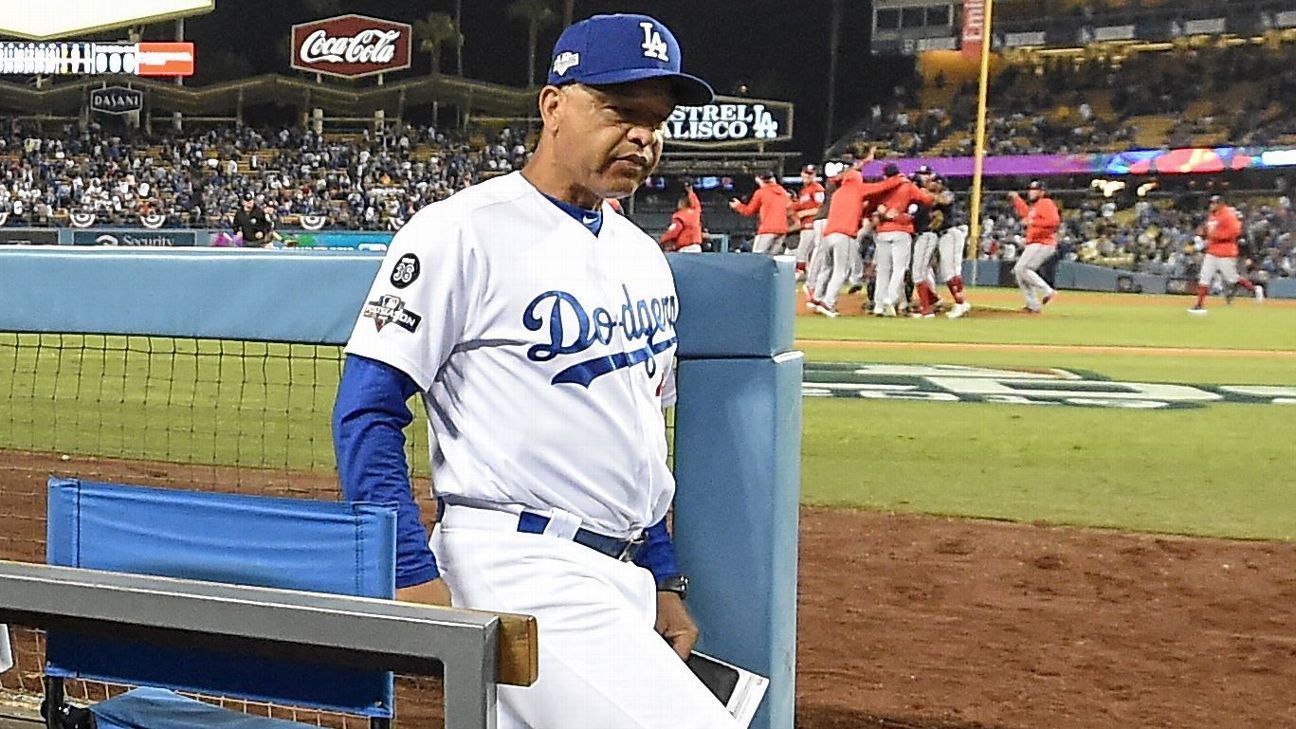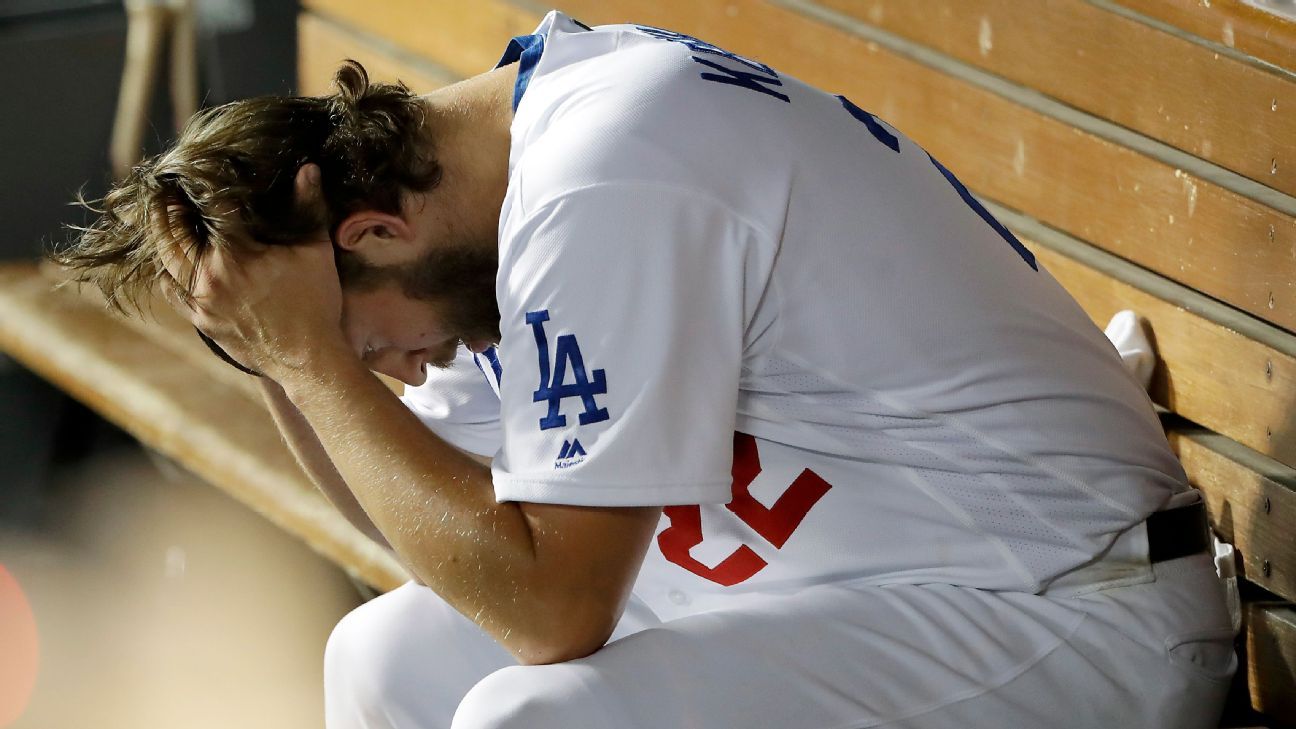LOS ANGELES -- The couches were noticeably missing from the center of the
Los Angeles Dodgers' clubhouse late Wednesday night. They were removed in preparation for another champagne celebration, perhaps around the seventh inning, when a two-run lead was handed from
Walker Buehler to
Clayton Kershaw.
What followed -- Kershaw allowing home runs to
Anthony Rendon and
Juan Soto on back-to-back pitches in the eighth inning,
Joe Kellysurrendering a grand slam to
Howie Kendrickin the 10th and the Dodgers suffering a
7-3 lossto the
Washington Nationals in Game 5 of the National League Division Series -- was a dizzying turn of events that left a
room full of players shell-shocked in its wake.
The Dodgers' 2019 season included a franchise-record 106 wins and an NL-best plus-274 run differential. But now -- suddenly, cruelly -- it is over, without a championship for a 31st consecutive year. L.A.'s baseball team is a dominant force that has captured seven consecutive division titles and is built for sustained winning, but continual postseason shortcomings provoke introspection. And the Dodgers have plenty to ask themselves as they pivot to what could be a fascinating offseason.
1. Will there be a change at manager?
Harry How/Getty Images
It sounds odd when you take a step back and remove the emotion from it. In four years, Dave Roberts has led the Dodgers to four postseason berths, three trips to the NLCS and two World Series appearances. Ten months ago, the franchise rewarded him with a four-year extension. But Roberts' in-game decision-making played a major role in the Dodgers' last two eliminations. Last year it was Game 4 of the World Series, the penultimate game of his team's season, when he removed
Rich Hillearlier than he should have, a turn of events rationalized as a miscommunication. This year, in the decisive game of the NLDS, he bungled the late-game bullpen strategy, going with Kershaw a little too long, bringing Kelly in for a second inning and not using lefty specialist
Adam Kolarek when he needed to. Maybe president of baseball operations Andrew Friedman -- with an expiring contract himself, but one that is expected to be resolved -- brings in somebody else. His longtime co-worker Joe Maddon is available.
2. So, Gerrit Cole and Anthony Rendon?
EDITOR'S PICKS
Assuming
Kenley Jansen opts into the final two years of his contract, he will be among only five players -- along with Kershaw, Kelly,
Justin Turner and
Kenta Maeda -- on the payroll for 2020 (not including pre-arbitration players and players eligible for arbitration). Those five will account for just under $75 million toward the Dodgers' competitive balance tax payroll. In other words, the Dodgers will have some money to spend this winter. They haven't been known to dole out big contracts under Friedman, but they currently have only two players signed beyond the 2021 season. Cole will command a lucrative, lengthy contract, but he would add a stabilizing presence at the top of the rotation, replacing Hill and Hyun-Jin Ryu. And he is from Southern California. Rendon -- said to be interested in a shorter-term deal with a higher average annual value -- could start at second base or allow Turner to transition to first. Signing either of those two would also lead to a ton of flexibility on the trade market.
3. What do they do with Kenley Jansen?
The Dodgers are set to pay Jansen $38 million over the next two years, but it doesn't sound as if they trust him as their closer. Roberts said otherwise in the lead-up to the postseason, dismissing the possibility of matching up in the ninth inning. But then, days later, Roberts alluded to the possibility of using Jansen in non-save situations. Jansen posted career highs in both ERA (3.71) and blown saves (eight) this season. His cutter was uncommonly hittable and his delivery was often out of sync. In a broader sense, Jansen hasn't been his same, dominant self since the 2017 World Series. He is still a highly competent reliever, but the Dodgers must ask themselves whether they can trust him as their closer moving forward.
4. What about Dustin May, Tony Gonsolin and Julio Urias?
Those three guys could easily make up three-fifths of next year's rotation, alongside Kershaw and Buehler. The only question, it seems, is whether the Dodgers believe they can do better. Down the stretch, May (22 years old), Gonsolin (25) and Urias (23) basically occupied hybrid roles in which they were available to either spot start, contribute multiple innings out of the bullpen or, if the game called for it, pitch in high-leverage situations. Urias spent the entire season as a multi-inning reliever on the major league club, while Gonsolin and May were in the minor leagues for most of the summer. The Dodgers might be able to justify more seasoning for May and Gonsolin, but Urias needs a set role -- either as a starting pitcher or a late-inning lefty.
5. Which defensive position will Cody Bellinger occupy?
As he showed while making a difficult catch up against the fence in the fourth inning of Game 5, Bellinger is a Gold Glove-caliber center fielder. He also had a Gold Glove-worthy season in right field, the position he began the season playing on an everyday basis. And several teammates would tell you he is the best defensive first baseman they have ever seen. The Dodgers moved Bellinger to center field and shifted
A.J. Pollock to left as the regular season was winding down because they believed it gave them their best defensive alignment. They love their versatility, so perhaps Bellinger continues to contribute at three positions moving forward. Or, perhaps, he becomes the NL version of
Mike Trout in center field -- except with a stronger throwing arm.



 Dave Roberts will have to own this Dodgers disaster
Dave Roberts will have to own this Dodgers disaster Dodger blues: Team stunned as dream dissolves
Dodger blues: Team stunned as dream dissolves 2019 MLB playoffs: Latest news and full postseason coverage
2019 MLB playoffs: Latest news and full postseason coverage




 you really think they care?
you really think they care?